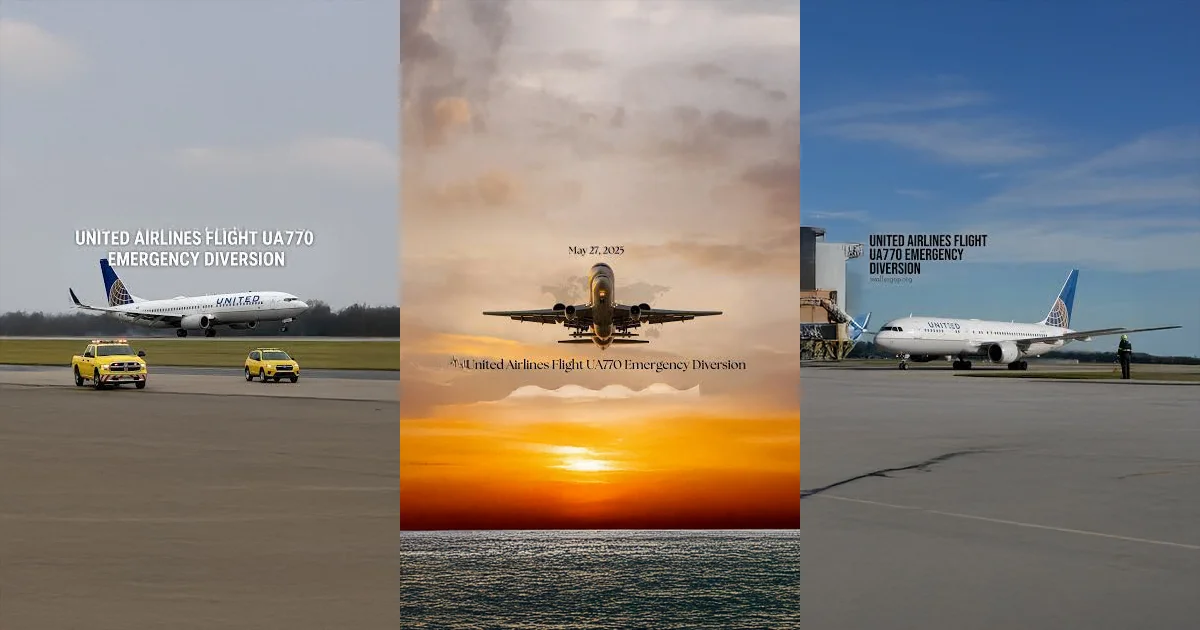Air travel is the safest means of transportation in the world. However, accidents such as the United Flight UA770 emergency diversion remind us that things that we can never predict might happen during a flight. People usually expect the flights to go to a successful route, but sometimes disasters take place. A safe outcome was achieved in this case due to quick action and well-trained crews. The accident also set in motion world attention, with the passengers and other aviation analysts seeking answers. Now we will investigate what occurred, why it happened, and what we can learn. By being informed, we are able to better figure out the mechanism of how safety in aviation works and why passenger confidence is doing so well.
United Flight UA770 Emergency Diversion: A Journey Interrupted
The United Flight UA770 emergency diversion began as a routine journey. The aircraft carried passengers eager to reach their final destination. But once again, as it happens to many stories about air travel a twist in the story changed the story. The plane had to face a technical issue just after it took off and this raised concern at the initial stage.
- Initial concern: A system warning alerted the crew about a potential mechanical issue.
- Decision to act: Following safety protocols, the crew decided to divert the flight.
- Emergency landing: The aircraft landed safely at a nearby airport where emergency services were waiting.
We should note that such diversions are rare, but they highlight why aviation rules are strict. By acting quickly, the crew minimized risks. This step ensured that passengers reached safety without harm. The incident also underlines the importance of having clear response procedures in place for every flight.
What Triggered the United Airlines Flight UA770 Incident?
One of the most pressing questions after the United Flight UA770 emergency diversion was the cause. While investigations often take time, initial reports pointed to a possible mechanical or system issue. Aviation experts suggest several likely causes when such diversions happen:
- A malfunctioning engine part or sensor alert.
- A system failure that affected in-flight operations.
- A medical emergency among passengers or crew.
In this particular case, technical problems appear to be the leading factor. Airlines always perform thorough checks after such incidents. Maintenance teams and investigators work together to uncover the exact cause. By doing so they can prevent similar issues in the future. For us as travelers, this transparency builds confidence in aviation safety.
Passengers’ Experience During United Flight UA770 Emergency Diversion
From a passenger’s perspective, the United Flight UA770 emergency diversion must have been unsettling. One moment, travelers were on a regular journey. Next they faced an emergency landing. We can imagine the emotions like anxiety, confusion, and concern for safety. Yet, the calm and decisive behavior of the crew likely helped ease fears.
Passengers later reported relief when the plane landed safely. Many expressed appreciation for the professionalism of the airline staff. Such experiences remind us that communication during crises matters. Reassuring announcements and clear instructions reduce panic. They also create trust in the airline’s commitment to passenger care. While unexpected the diversion ended with safety as the top priority, and that outcome matters most.
Safety Protocols in Action: How the Crew Responded
The United Flight UA770 emergency diversion displayed the operation of the airline’s security measures on the ground. This situation showed why flight crews undergo so much training in case of emergencies. Each action, the identification of a threat to the landing itself, had a path.
Key safety responses included
- Immediate assessment of the technical warning.
- Quick decision-making to divert the aircraft.
- Coordinated landing supported by ground emergency services.
We must remember that airline crews train through simulations of such crises. Their ability to stay calm and act fast is the result of preparation. In this case, the crew’s expertise made all the difference. For us as passengers, knowing that such protocols exist is deeply reassuring.
Aftermath of the United Flight UA770 Emergency Diversion
After the successful diversion by the flight United UA770, the condition of the passengers came under consideration. Airlines are aware of the fact that emergencies produce stress. Thus, United Airlines was able to organise accommodation and assistance. It has been reported that accommodation, meals, and travel arrangements are taken care of.
The airline also collaborated with maintenance teams in order to inspect and fix the affected aircrafts. This was important in order to avoid the occurrence of the same problems in the future. The aviation industry learns each time it faces the diversion process. Learning about the incident, airlines can enhance the safety regime and even improve their response plan. The outcome was finally that safety is number one, followed by the comfort of passengers and the regaining of trust.
Lessons Learned from the UA770 Emergency Landing
Every emergency teaches us something. The United Flight UA770 emergency diversion highlights the importance of constant readiness. Airlines can improve by focusing on several areas
- Constant check-up: Regular check-up inhibits risks of technical breakdown.
- Ongoing training: Crews are required to simulate handling rare but grave incidents.
- Effective communication: It makes passengers feel safer when we can communicate effectively, fast, and to the point.
As travelers, we benefit from these lessons. We can feel confident that airlines will continue to evolve. Aviation is built on trust, and events like this only strengthen the need for safety-first thinking.
Conclusion
The United Flight UA770 emergency diversion did not turn out to be a pleasant surprise, but the landing was successful. The passengers were safe because of the actions of the crew and the provisions by the airline. Although the cause remained under review, the learning factors are obvious: safety, preparation, and time are life-saving factors. As world travelers, we are ready to believe that the aviation industry is paying attention to such incidents. Every accident translates to better safety so that subsequent trips will be safer.



